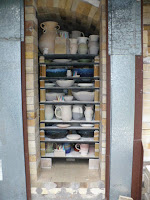
 A neighbor generously lent me his wood splitter for a few weeks.
A neighbor generously lent me his wood splitter for a few weeks. Before I could start splitting any wood, I needed to clean up the area where the wood would be stacked.
There were stacks of bricks all around the kiln yard. I had to get more organized!
Hard bricks can always be used someplace, so were stacked together, out of the way. Not really too many of those left. Of the remaining soft bricks, many had dried mortar on them, and there were chunks of the arch. In the right photo, you can see 16 double-paper, grocery bags of soft bricks. The dry mortar just chips a chunk out of the brick when trying to remove it, so those bricks are 'toast', trash, unusable. Unless someone wants to grind them down to grog. A big, labor-intensive job, and only worth it if you can use the grog, as for kiln insulation.
And more trash, like rain-damaged cardboard boxes that used to hold bricks.
In the first photo is the result of about an hour-and-a-half of splitting wood.
I stacked it later, and think it is about 1/8 a cord. I need to pick up my pace, and/or find someone to help split wood. I did get an offer from someone, I just find it hard to ask someone to come over to do very hard labor. I have to get past that.
There is a variety of wood that I had accumulated last fall. Already, I've split redwood, fir, oak and pine limbs. Such a variety of wood for the pots. Sometime, it might be useful to fire with just one type of wood, to determine the effects of each wood. This first wood-fire will be using what I have scavenged/saved.


















